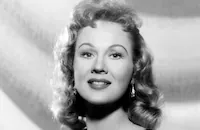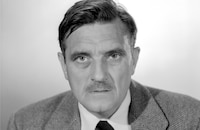Devil's Canyon

Brief Synopsis
Cast & Crew
Alfred Werker
Virginia Mayo
Dale Robertson
Stephen Mcnally
Arthur Hunnicutt
Robert Keith
Film Details
Technical Specs

Synopsis
In a small Arizona town, in 1897, outlaw Abby Nixon reluctantly warns former marshal Billy Reynolds, who once spared her life, that two of her cohorts, Bud and Cole Gorman, are coming to kill him. Unarmed because of strict, new gun laws, Billy borrows a pair of six-shooters and meets his assailants head on. After a bloody gunfight, Bud and Cole lay dead, and Billy is arrested for murder. Despite pleas of self-defense, Billy is found guilty and sent to Devil's Canyon, a tough prison in the scorching desert. Although Warden Steve Morgan sympathizes with Billy, head guard Captain Wells is antagonistic, as Billy once slugged him for roughing up a suspect. Billy is also threatened by Bud and Cole's revenge-hungry brother Jesse, who is incarcerated at Devil's Canyon with fellow outlaws Red and Joe. One day, Abby, who is Jesse's sweetheart, arrives at the prison, having been found guilty of armed robbery. To protect Abby from the male prisoners, the warden assigns her to a room in the prison hospital, and Abby becomes Dr. Betts's assistant. Later, during dinner, Jesse throws a knife at Billy, and a brawl erupts. Both men are sent to the hospital, where Jesse and Abby enjoy a brief reunion. Abby then must tend to Billy's wound and treats him rudely, despite their mutual attraction. The next day, while working on a road gang, Jesse accuses Billy of slaughtering his brothers and tries to force him to reveal how he knew they were in town. That night, Abby bribes a guard to bring Jesse to see her at the hospital. There, Abby tells the sex-starved Jesse about the jailbreak she is planning and convinces him to wait until he is free to exact revenge on Billy. Abby then tries to talk Billy into participating in the escape, but he refuses. When Abby next meets with Jesse, he babbles incoherently about the escape, worrying Abby. Soon after, an informer alerts Wells and the warden about the breakout, and the warden subtly warns Abby not to take her chances with a brutal killer like Jesse. During a search of Billy's cell, Wells discovers two knives, surreptitiously planted by Jesse, and sends him to solitary confinement. That night, Abby hides some guns, which an outside cohort had shipped to her among some medical supplies, in the examination room. Dr. Betts, who believes that Abby and Billy belong together, then brings Billy to see her, and while changing the bandage on Billy's knife wound, she once again talks to him about joining the breakout. When Billy refuses, stating that he wants her to lead a decent life, Abby becomes emotionally conflicted. After Billy returns to solitary confinement, Red and Joe feign heat stroke so that they will be sent to the hospital. Abby arms them, and the escape begins. Red and Joe take three guards hostage and open Jesse's cell. The demented Jesse holds the warden at gunpoint and, declaring his intention to turn all the convicts loose on the nearby town and blow up the prison, demands access to the prison's dynamite. When the warden refuses, Jesse shoots Wells in cold blood. Now fearful of Jesse, Abby steals the key to Billy's cell and frees him. As the liberated convicts create havoc in the prison, Jesse discovers Billy's empty cell and slaps Abby for betraying him. Jesse then begins to hunt for Billy, but armed with one of Abby's guns, Billy is able to outmaneuver Jesse and his men. Having taken over the machine gun in the guard tower, Billy shoots Jesse and sprays enough bullets over the other convicts' heads to scare them back into their cells. After Abby runs to Billy's open arms, the grateful warden predicts that two pardons may be in store for them.

Director

Alfred Werker
Cast

Virginia Mayo

Dale Robertson

Stephen Mcnally

Arthur Hunnicutt

Robert Keith

Jay C. Flippen
George J. Lewis

Whit Bissell

Morris Ankrum
James Bell
William Phillips

Earl Holliman

Irving Bacon
Jim Hayward
John Maxwell

Tom Powers
Harry Cheshire
Lee Erickson
John Cliff
Fred Coby
Frank Mills

Glen Strange
Murray Alper
Richard Thorne
Frank Griffin
Charles Hamilton
Peter Ortiz
Jack Stoney
George Sherwood
Bob Morgan
Ted Ryan
Ray Hyke
Richard Reeves
Lane Bradford
Eric Alden
Ronald Shaan
Gregg Martell
Harold "stubby" Kruger
James R. Scott
Mickey Simpson
Jack Perry
Harvey Parry
Charles Cane
Sam Flint
Dick Rich

Paul Fix
Frank Marlowe
Larry Blake
Stan Blystone
Crew
Daniele Amfitheatrof
C. Bakaleinikoff
Mel Berns
Frederick Hazlitt Brennan
Cliff Broughton
Bennett R. Cohen
Albert S. D'agostino
Edward Donahue
Harry Essex
Larry Germain
James Gooch
Edmund Grainger
Edmund Grainger
Julien Gunzberg
M. L. Gunzberg M.d.
Howard Hughes
Frederic Knudtson
Gene Lewis
Richard Mcwhorter
Jack Mills
Nicholas Musuraca
Jack Okey
Gene Palmer
Norton S. Parker
Clem Portman
Darrell Silvera
Earl Wolcott
Lothrop Worth
Michael Woulfe

Film Details
Technical Specs

Articles
Virginia Mayo (1920-2005)
She was born Virginia Clara Jones in St. Louis, Missouri on November 30, 1920, and got her show business start at the age of six by enrolling in her aunt's School of Dramatic Expression. While still in her teens, she joined the nightclub circuit, and after paying her dues for a few years traveling across the country, she eventually caught the eye of movie mogul Samuel Goldwyn. He gave her a small role in her first film, starring future husband, Michael O'Shea, in Jack London (1943). She then received minor billing as a "Goldwyn Girl," in the Danny Kaye farce, Up In Arms (1944). Almost immediately, Goldwyn saw her natural movement, comfort and ease in front of the camera, and in just her fourth film, she landed a plumb lead opposite Bob Hope in The Princess and the Pirate (1944). She proved a hit with moviegoers, and her next two films would be with her most frequent leading man, Danny Kaye: Wonder Man (1945), and The Kid from Brooklyn (1946). Both films were big hits, and the chemistry between Mayo and Kaye - the classy, reserved blonde beauty clashing with the hyperactive clown - was surprisingly successful.
Mayo did make a brief break from light comedy, and gave a good performance as Dana Andrews' unfaithful wife, Marie, in the popular post-war drama, The Best Years of Their Lives (1946); but despite the good reviews, she was back with Kaye in The Secret Life of Walter Mitty (1947), and A Song Is Born (1948).
It wasn't until the following year that Mayo got the chance to sink her teeth into a meaty role. That film, White Heat (1949), and her role, as Cody Jarrett's (James Cagney) sluttish, conniving wife, Verna, is memorable for the sheer ruthlessness of her performance. Remember, it was Verna who shot Cody¿s mother in the back, and yet when Cody confronts her after he escapes from prison to exact revenge for her death, Verna effectively places the blame on Big Ed (Steve Cochran):
Verna: I can't tell you Cody!
Cody: Tell me!
Verna: Ed...he shot her in the back!!!
Critics and fans purred over the newfound versatility, yet strangely, she never found a part as juicy as Verna again. Her next film, with Cagney, The West Point Story (1950), was a pleasant enough musical; but her role as Lady Wellesley in Captain Horatio Hornblower R.N. (1951), co-starring Gregory Peck, was merely decorative; that of a burlesque queen attempting to earn a university degree in the gormless comedy, She¿s Working Her Way Through College (1952); and worst of all, the Biblical bomb, The Silver Chalice (1954) which was, incidentally, Paul Newman's film debut, and is a film he still derides as the worst of his career.
Realizing that her future in movies was slowing down, she turned to the supper club circuit in the 60s with her husband, Michael O'Shea, touring the country in such productions as No, No Nanette, Barefoot in the Park, Hello Dolly, and Butterflies Are Free. Like most performers who had outdistanced their glory days with the film industry, Mayo turned to television for the next two decades, appearing in such shows as Night Gallery, Police Story, Murder She Wrote, and Remington Steele. She even earned a recurring role in the short-lived NBC soap opera, Santa Barbara (1984-85), playing an aging hoofer named "Peaches DeLight." Mayo was married to O'Shea from 1947 until his death in 1973. She is survived by their daughter, Mary Johnston; and three grandsons.
by Michael T. Toole

Virginia Mayo (1920-2005)
Devil's Canyon
The story is set at the Arizona Territorial Prison, where some 500 male inmates grow ever more tense after female outlaw Abby Nixon (Mayo) is also imprisoned there. Ex-marshal Billy Reynolds (Robertson), incarcerated after killing two men in self-defense, learns that Jessie Gorman (Stephen McNally), the murderous brother of the two men he killed, is also a convict.
Matters come to a head when Abby helps Jessie plan an escape at the same time she's falling in love with Billy. The climactic escape has Billy facing down the other convicts with a Gatling gun.
Robertson was a natural at playing Western types who heeded the advice of fellow Oklahoman Will Rogers, who once told him he should never take an acting class. Robertson was inducted into the Hall of Great Western Performers of the National Cowboy and Western Heritage Museum in 1983. Mayo, a city girl born in St. Louis, also made her share of Westerns including Along the Great Divide (1951), The Big Land (1957) and Fort Dobbs (1958).
Producer: Edmund Grainger
Director: Alfred Werker
Screenplay: Frederick Hazlitt Brennan, Harry Essex, from story by Bennett Cohen and Norton S. Parker
Cinematography: Nicholas Musuraca
Art Direction: Albert S. D'Agostino, Jack Okey
Original Music: Daniele Amfitheatrof
Editing: Gene Palmer
Costume Design: Michael Woulfe Principal Cast: Virginia Mayo (Abby Nixon), Dale Robertson (Billy Reynolds), Stephen McNally (Jessie Gorman), Arthur Hunnicutt (Frank Taggert), Robert Keith (Warden Steve Morgan), Jay C. Flippen (Capt. Wells).
C-92m. Closed captioning.
by Roger Fristoe
Devil's Canyon
Quotes
Trivia
Notes
The working title of this film was Arizona Outpost. As noted in the onscreen credits, the film was presented in 3-D, using the Natural Vision 3-D process. The viewed print, however, was in standard format. The opening credits conclude with the following written statement: "Arizona Territory in 1897 was the last of the old frontier. The story we are about to tell is well known to historians. Names have been changed but the lust and brutality, the love and sacrifice of the people involved remain for the record unchanged. The woman outlaw and her lovers belong now to folklore-in 1897 they lived."
According to a January 1953 Los Angeles Times item, RKO assigned William Bowers to write the film's screenplay, but his contribution to the final picture has not been determined. RKO borrowed Virginia Mayo from Warner Bros. and Dale Robertson from Twentieth Century-Fox for the production. Jill Jarmon and Michael Granger are listed as cast members in Hollywood Reporter production charts, but their appearance in the final film has not been confirmed. Production charts also include Byron Foulger in the cast, but he did not appear in the picture. In 1981, Daily Variety announced that Richard Schwarz, owner of the Thalia theater in New York, was restoring the film and screening it in 3-D.
















